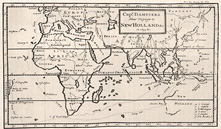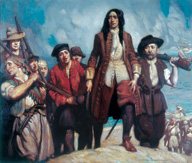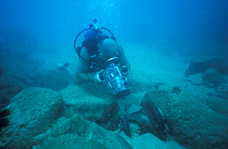| William Dampier became famous after
his epic pirating travels were published in A
New Voyage Around the World in 1697. The British Admiralty promised him a ship to
examine the uncharted eastern coast of new Holland via the Pacific
Ocean round Cape Horn. It was thought he might also solve the mystery
of the mythical Terra Australis.
Delays with the fit-out and provisioning
of Roebuck forced Dampier to take a much longer voyage via the
Cape of Good Hope. He first made landfall at a place he named ‘Sharks
Bay’. While
on this coast he produced a chart and collected and described many
plants, shells and other specimens including fish marine mammals,
reptiles, shells and one insect.

Above: Captain Dampier’s New Voyage
to
New Holland & c.
in 1699. |
With his ship leaking, Dampier was
forced to abandon his plans just short of his destination and
return home, leaving the discovery of the east coast of New
Holland to James Cook.
Though Roebuck sank at Ascension
Island in February 1701, Dampier salvaged his journals,
some of his Shark Bay plant specimens and a few shells. |
His new book, A
Voyage to new Holland, was another best seller.
Dampier was widely recognised by his collections and his vivid
descriptions as ‘Australia’s first natural historian’.
‘…I sent my Boat ashore to the Island, to see
what Convenience there was to haul our Vessel ashore in order
to be mended…but we could not land…I saw she would
be a long Time in Repairing; which was one great Reason why I
could not prosecute my Discoveries further. Wm
Dampier. Quoted in the Masefield edition, 1906, Vol II: 543.
‘The World is apt to judge of every
thing by the Success; and whoever has ill Fortune will hardly
be allow’d a good
Name.’ Letter from Dampier to the Earl of Pembroke,
President of the Privy Council. Reproduced in the Williamson edition,
1939: xxii.
 |
The landing of Dampier, c. 1925
Norman Lindsay 1879 – 1969
Oil on canvas
Norman Lindsay was captivated by stories of pirates and their
ships. He painted his impression of William Dampier landing
in Australia at the head of his men from his privateer Cygnet in
1688. Dampier also recorded this event in his journal.
On loan courtesy of Kerry Stokes collection, Perth
1988.037 |
The fourth day of January 1688 we fell in with the land of
New Holland… We sent our boat ashore to speak with the
natives but they would not abide our coming so we spent three
days in seeking their houses…We tarried here till the
twelfth day of Feb, in which time we cleaned our ship, mended
our sails, filled our water.. the wind being NNE we stood out
between the island and the shoals… Reference:
Sloan 3236, Folio 222, British Library.
Drawings of their Majesties Ship Roebuck
R.T. (Bob) Sexton joined the Museum’s team to research
the ship which resulted in the production of these detailed
plans and report. He found that Roebuck was one
of a number of small fireships constructed around 1689. Roebuck was
not built to a standard design and there has been considerable
disagreement on its size and appearance. |
|
I dined with Mr Pepys, where Captain Dampier, who had been
a famous buccaneer….He is now going abroad again by the King’s
encouragement, who furnished a ship of 290 tons.

Above: Museum diver Geoff Kimpton examining
the bell and clam.
The
Discovery of the Roebuck
In 1999, to mark the Tricentennial of William Dampier’s
landing at Shark Bay, these expeditions became international with
the decision to search for the wrecks of Dampier’s and de
Freycinet’s ships Roebuck and Uranie off the Ascension and
Falkland Islands in the Atlantic.
Funds for the expedition were
provided to the Western Australian Museum by private donors and
the Shire of Shark Bay. The Roebuck was found 300 years
almost to the day since the ship was lost. The wreck still contained
some of the Dampier’s
specimens including a clam shell, perhaps one he had collected
in Shark Bay. At the request of the Island’s
administrator, the ship’s bell and clam shell were raised
with the assistance of local divers. Both objects were conserved
and returned to the Island with replicas presented to the Western
Australian Museum.
|


